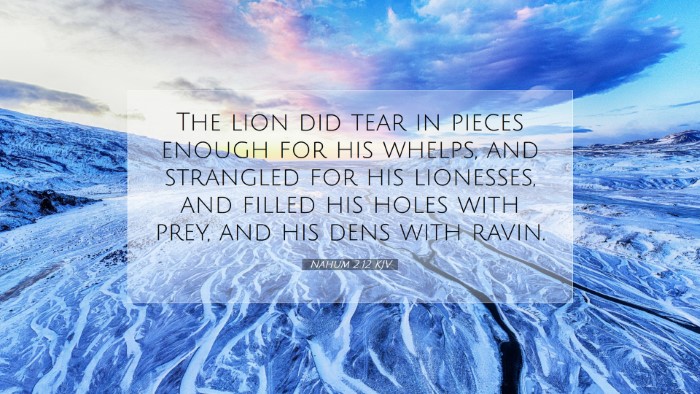Old Testament
Genesis Exodus Leviticus Numbers Deuteronomy Joshua Judges Ruth 1 Samuel 2 Samuel 1 Kings 2 Kings 1 Chronicles 2 Chronicles Ezra Nehemiah Esther Job Psalms Proverbs Ecclesiastes Song of Solomon Isaiah Jeremiah Lamentations Ezekiel Daniel Hosea Joel Amos Obadiah Jonah Micah Nahum Habakkuk Zephaniah Haggai Zechariah MalachiNahum 2:12
Nahum 2:12 KJV
The lion did tear in pieces enough for his whelps, and strangled for his lionesses, and filled his holes with prey, and his dens with ravin.
Nahum 2:12 Bible Commentary
Commentary on Nahum 2:12
Nahum 2:12 states: "The lion did tear in pieces enough for his whelps, and killed for his lionesses, and filled his holes with prey, and his dens with ravin." This verse, rich in imagery, portrays a scene of devastation and the consequences of oppressive power, primarily focusing on the fall of Nineveh, the capital of the Assyrian Empire.
Contextual Background
The book of Nahum is a prophetic text that proclaims the imminent judgment of God against Nineveh for its cruelty and idolatry. Nahum's role as a prophet was to assure Israel of God's justice following the Assyrian oppression. This verse is pivotal as it captures the essence of divine retribution against a once-mighty foe.
Analysis of the Text
In Nahum 2:12, the imagery of the lion—often a symbol of power and ferocity—serves to illustrate the Assyrians' violent nature and imperialistic tendencies. Below are key points extracted from public domain commentaries:
-
Matthew Henry's Commentary:
Henry emphasizes the fierce attributes of the lion as a metaphor for the Assyrians under God's judgment. He notes that the lion provides for its young, which symbolizes how Assyria once prospered and provided for its empire through conquest and destruction. Yet, this prosperity will turn to ruin, as God decrees the end of their reign.
-
Albert Barnes' Notes:
Barnes interprets the verse as a declaration of God's will to bring down those who are cruel and consumed by greed. He points to the "holes" and "dens" filled with prey—a reference to the violent plunder by the Assyrians. In his interpretation, Barnes emphasizes God’s sovereignty in ensuring that the oppressors, who once thrived on exploiting others, will face their demise.
-
Adam Clarke's Commentary:
Clarke elucidates the symbolism of the lion as it relates to strength and fear. He views the text as a powerful image of the fall of cruelty. Clarke remarks on how the Assyrians, who acted like lions in their aggression, will be rendered powerless before the might of God, reinforcing the theme of divine justice.
Theological Implications
The implications of Nahum 2:12 are profound for contemporary readers, especially those in pastoral contexts. The verse can be understood as a manifestation of God's justice and the ultimate accountability of nations and individuals. Some key theological reflections include:
-
God's Justice:
Nahum 2:12 serves as a reminder that God will vindicate the oppressed and bring judgment upon the oppressors. This is an encouragement for believers to trust in God's timing and His righteous judgment, especially in times of suffering or injustice.
-
Symbolism of Divine Sovereignty:
By using the lion as a symbol of both strength and vulnerability, the text illustrates that true power lies with God alone. It conveys that the most formidable earthly powers, much like the lion, can fall under God's decree.
-
The Cultural Context of Assyrian Power:
Understanding the Assyrian Empire's historic context enhances the richness of this verse. Scholars must consider how Nahum's prophecy spoke to the fears and anxieties of the Jewish people during the Assyrian oppression.
Practical Applications
For pastors and theologians, Nahum 2:12 offers various applications:
-
Encouragement for the Oppressed:
This verse can serve as a source of hope for congregants who feel marginalized by powerful entities. It reassures them that God sees their suffering and remains in control.
-
Call to Responsibility:
It invites leaders and communities to reflect on their actions and the treatment of others. Just as God judges nations, individuals and communities must also be held accountable for their actions.
-
The Assurance of Divine Protection:
Believers can take comfort that while the world may appear dominated by oppressive powers, God's justice will ultimately prevail. Pastors can emphasize God's faithfulness as a central theme in their messages.
Conclusion
In summary, Nahum 2:12 presents a vivid portrayal of divine judgment on the Assyrian Empire, symbolically represented through the figure of a lion. The insights from Matthew Henry, Albert Barnes, and Adam Clarke collectively highlight the themes of justice, divine sovereignty, and the consequences of oppression. As this verse resonates through the ages, it continues to offer profound encouragement and reminders of God's ultimate authority over human affairs, making it a rich vein of reflection for pastors, students, and scholars alike.


